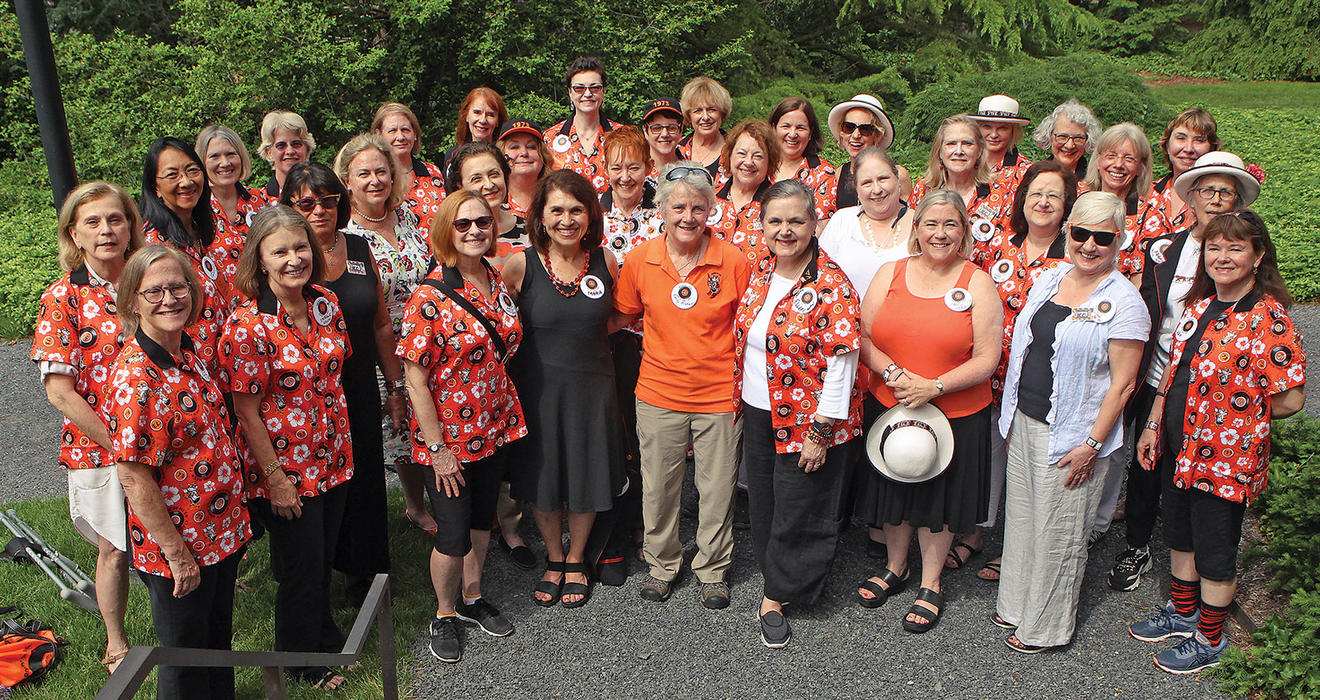
Trailblazers of Coeducation
The women of ’73 reflect on awkward moments and lifelong rewards
The women of the Class of ’73 were pioneers — not just once, but again and again.
The first female officer at an eating club. The only woman in an upper-level biology course. The first woman to win the Pyne Honor Prize. And then: the only woman in the room at the law firm, and the technology company, and the scientific institution. “I never felt uncomfortable walking into a room and being the only woman, because I had done that so many times at Princeton,” says Jane Leifer.
As members of the first undergraduate class at Princeton that included women for all four years, they were the guinea pigs who led coeducation at a 223-year-old institution. In the fall of 1969, 101 female first-year students and 70 female transfer students arrived on campus. About 40 women of ’73 gathered at Prospect House during Reunions this year for a breakfast to reminisce about their early days on campus and to reflect on the way they blossomed in the face of challenges.
Victoria Bjorklund remembers registering for gym class in Dillon with a punch card. When she got to the front of the line, there was nothing left but football. “The tennis coach heard what happened and said, ‘I’ll take her,’ ” she recalls. Later she played on the first women’s basketball team and became part of what is believed to be the first undergraduate married couple, with Hank Bjorklund ’72. At the predominantly male law firm where she later worked, she spoke up for a friend who was pumping breast milk in the ladies’ room, leading to the firm’s first lactation room. “As the kind of gritty woman who went to Princeton, I knew how to pick my battles and explain what we needed,” she says.
June Fletcher was singled out by the press during her first days on campus as “Miss Bikini USA” — she had won the beauty contest as a high school student. Looking back, she is stunned at the blatant sexism. “It was considered newsworthy that you could be pretty and smart,” she says. At the first fall meeting of the Press Club, the faculty adviser said he didn’t want any “g0-go girls” to join. She became a journalist anyway, spending more than a decade as a reporter for The Wall Street Journal. “Going through that crucible, everything else is easy after,” she says.
You “had to have a certain amount of confidence or naiveté,” says Ellen Porter Honnet, who transferred as a sophomore in 1970 from Middlebury. Having lived abroad, she regarded coming to Princeton as a “cross-cultural experience. I was in a foreign country,” she says. Dismayed that there was little support for transfers, she raised the issue with the administration and was asked to help the University with strategies to guide transfer students.
“None of us are shrinking violets,” says Robin Pearse-Drance, who served in the Merchant Marines.
Coeducation was successful “because of your courage, your gumption, your willingness to be pioneers and roll with the punches,” professor emerita Nancy Weiss Malkiel told the group. Malkiel, who wrote Keep The Damned Women Out: The Struggle for Coeducation, recalled arriving at Princeton as a faculty member in 1969, when there were three women in the professorial ranks. When she walked into her first all-male precept, “All the men stood up and pulled out my chair,” she said.
In 1973, Leifer wrote an article for PAW describing many of the cringe-worthy moments of coeducation, such as preceptors calling on the students to offer “the woman’s point of view.” “I was determined to leave Princeton purged of all those [negative] feelings” about the University, says Leifer. Today, she says, “Ninety percent of the good remains, and we laugh off the bad.”
As the women enter a new phase of life — some are retired, some are thinking about it — they continue to rack up firsts. Starting next month, Nancy Teaff will be the class’s first female president. When she visits campus and sees all the women students, she says,“It makes me think, ‘Look at what we started.’”
The women of ’73 at their reunion breakfast (pictured above), in alphabetical order: Ruth Berkelman, Victoria Bjorkland, Melinda Boroson, Arlene Burns, Louise Carlson, Elaine Chan, Maureen Ferguson, Gail Finney, Emily Fisher, June Fletcher, Joan Gallos, Jane Genster, Harriette Hawkins, Robin Herman, Jan Hill, Melissa Hines, Katherine Holden, Ellen Honnet, Robin Krasny, Jane Leifer, Nancy Marvel, Mara Melum, Julia O’Brien, Robin Pearse-Drance, Beth Rom-Rymer, Diana Savit, Sara Sill, Anne Smagorinsky, Gale Stafford, Nancy Teaff, Lisa Tebbe, Macie Van Rensselaer, Jean Wieler, and Stephanie Wilson






1 Response
Ken Hall ’71
7 Years AgoNot the First
I attended the wedding of Judith Corrente ’70 and David Schankler ’71 in the Chapel May 8, 1971, which was earlier than the one mentioned as the first undergraduate marriage in the July 11 issue.